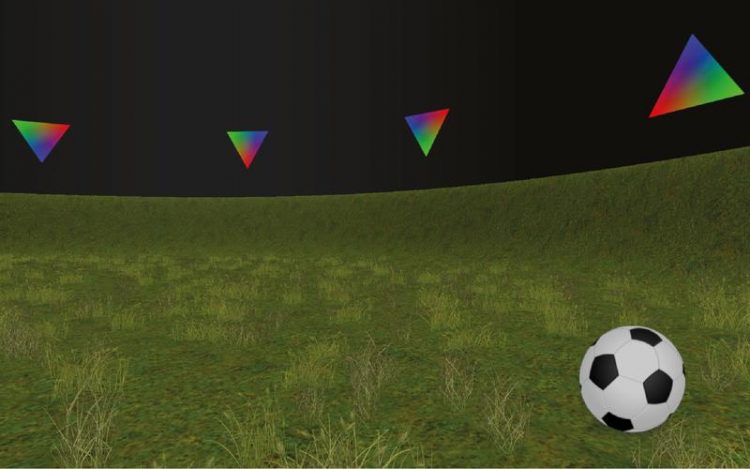Researchers are watching the brain memorizing rooms

Study participants navigated in a virtual arena using a keyboard similar to playing a computer game. MPI CBS
In their recent publication in Nature Communications, they show that newly formed memories affect how we perceive the world around us: the more familiar our environment is, the fewer information needs to be integrated. This is directly reflected in our brain activity and can now be measured.
The remarkable ability of our brains to form maps of the environment and retrieve them on demand requires several complex neural calculations. Many of these are executed along a neural pathway that extends from the visual cortex to higher-level memory centers in our brain.
To understand how individual brain areas along this pathway work together to control our behavior, Matthias Nau and Christian Doeller from the MPI CBS have developed an algorithm, together with their colleagues from Norway.
This so-called encoding model enables them to directly link the brain activity of participants with their behavior and their ongoing memory formation. In particular, the team wanted to know how the human brain maps the environment during a natural and very complex behavior – namely spatial navigation.
Natural behavior observed in a virtual environment
To obtain a broad perspective on the human brain, the scientists used functional magnetic resonance imaging – a technique that can measure the activity of the entire brain via blood flow. The study participants were placed in a high field MRI scanner (7-tesla ) and navigated in a virtual arena using a keyboard similar to playing a computer game. They were asked to memorize the positions of hidden objects.
“In order to understand how our participants oriented themselves in this task, we analyzed how their brain activity reflected the direction they were moving, within the virtual world, at any given time,” explains Matthias Nau. Without a sense of direction this task would not have been possible.
“We built an encoding model of their facing direction to estimate the influence of direction on neuronal activity in each part of the brain. Using this model, we were then able to predict, how the activity would unfold in new data from the same participant.”
To do this, the algorithm simulated not just one, but many possible versions of how each brain area might represent direction. The researchers identified which version of the model best predicted new data and were thus able to map previously unknown details of the directional code throughout the brain.
Brain activity reflects behavior controlled by memory
The novel analysis method made it possible to measure human perception of direction with unprecedented detail. The scientists not only observed an increase in brain activity in regions that filter spatial information from visual stimuli, but were also able to find clues, particularly in the higher memory regions, as to how well the participants remembered the locations of the objects they were looking for.
The results suggest that the process of encoding the world and the objects in it, i.e. cognitive mapping, influences how the entire network of regions in the brain processes information that we are currently deriving from our environment. The interaction of different visual and memory-forming brain areas is thus much more directly related to memory-controlled behavior than has been known up to now.
We typically think of memory as discrete events from our past that we can call to mind. But why do we have memories in the first place? They enable us to learn from our past and to adapt our behavior accordingly in the future. Here, the scientists show that our memories have a direct influence on how we perceive the world around us, and that this interplay between perception and memory guides our behavior in everyday life.
The scientists are making the newly developed method available to the scientific community as an open-access analysis tool so that it can also be applied to other data, such as electrical brain data (EEG), or even in animal models. In this way, the neuronal processes involved in memory formation and spatial navigation can be investigated even more comprehensively.
Matthias Nau
Doktorand
matthias.nau@ntnu.no
“Behavior-dependent directional tuning in the human visual-navigation network”
by Matthias Nau, Tobias Navarro Schröder, Markus Frey & Christian F. Doeller
in: Nature Communications (2020)
Media Contact
All latest news from the category: Studies and Analyses
innovations-report maintains a wealth of in-depth studies and analyses from a variety of subject areas including business and finance, medicine and pharmacology, ecology and the environment, energy, communications and media, transportation, work, family and leisure.
Newest articles

NASA: Mystery of life’s handedness deepens
The mystery of why life uses molecules with specific orientations has deepened with a NASA-funded discovery that RNA — a key molecule thought to have potentially held the instructions for…

What are the effects of historic lithium mining on water quality?
Study reveals low levels of common contaminants but high levels of other elements in waters associated with an abandoned lithium mine. Lithium ore and mining waste from a historic lithium…

Quantum-inspired design boosts efficiency of heat-to-electricity conversion
Rice engineers take unconventional route to improving thermophotovoltaic systems. Researchers at Rice University have found a new way to improve a key element of thermophotovoltaic (TPV) systems, which convert heat…



